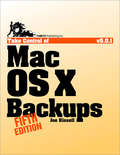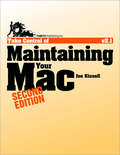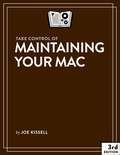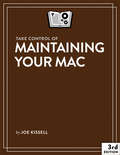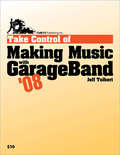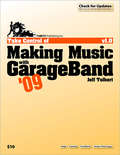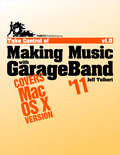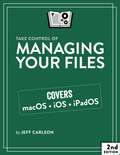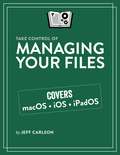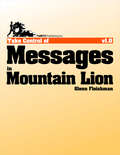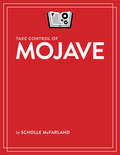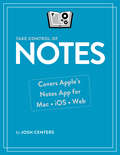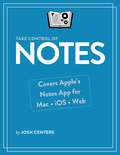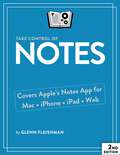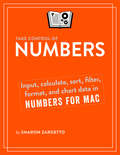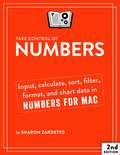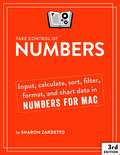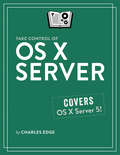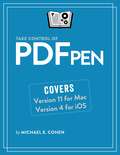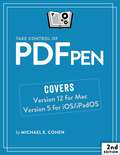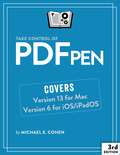- Table View
- List View
Take Control of Mac OS X Backups
by Joe KissellIncludes coupons worth $30 off Data Backup and 10% off CrashPlan Although the 228-page ebook is organized so you can start backing up without reading every page, the full ebook will teach you to: Design a reliable backup system. You'll learn how to develop a backup system that is not only thorough, ensuring that all your data is safe, but also easy to manage. Talk like an expert. You'll understand terms like "versioned backups," "push" and "pull" backups, "duplicates," "server," "client," "incremental," "differential," "hard link," "metadata," "mirroring," and "snapshot." Shop for hardware. You'll discover the pros and cons of different backup media options such as hard drives (with USB, FireWire, or eSATA interfaces--and with or without full-disk encryption), flash drives, tape drives, RAIDs, Drobo storage devices, CDs and DVDs, Time Capsules, and NAS and SAN devices. Choose backup software. You'll learn about 14 key features and find overviews of 12 noteworthy backup products (an online appendix covers nearly 100 options). You'll also get Joe's personal recommendations to help you sort through the possibilities presented in this section. Make backups. No matter what backup software you decide to use, Joe provides a conceptual walk-through of the entire process, offering basic information for people who've never made a backup before and savvy, real-world suggestions for making the backup process as easy as possible. He also provides specific steps for working with Time Machine. Recover lost data. Use your backup to recover lost data successfully in the event of a hard disk crash or other calamity. The ebook also includes an appendix aimed at people who want to create their own backups using Unix on the Mac command line, and it explains how to back up your Windows volume if you run Windows on your Mac.
Take Control of Maintaining Your Mac
by Joe KissellRead this book to learn the answers to questions such as: How can I tell if my Mac is likely to have trouble? How can I find out which unnecessary files are taking up space on my disk? Should I defragment my hard disk and repair permissions regularly? What are the safest ways to clean dust and crud from my Mac? What is the best way to keep my software up to date?
Take Control of Maintaining Your Mac
by Joe KissellLearn how to prevent problems with your Mac and keep little irritations from turning into major headaches. Joe Kissell shows you a simple maintenance regimen that will keep your Mac humming. It starts with a good spring cleaning and then adds simple daily, weekly, monthly, and yearly tasks, as well as ongoing monitoring.
Take Control of Maintaining Your Mac (3.0)
by Joe KissellMacs, like all machines, are prone to break down eventually—in either a physical sense (a component going bad) or a logical sense (files becoming corrupted, apps misbehaving). You can reduce the risk of such problems, and minimize the damage when they do occur, with a regular maintenance regimen. This book contains simple steps you can take to keep your Mac humming.
Take Control of Making Music with GarageBand '08
by Jeff TolbertSeattle musician Jeff Tolbert's step-by-step instructions guide beginning and intermediate users through using GarageBand's built-in loops to create three songs, explaining not only how to use GarageBand's editing and mixing features but also how to be playful and creative while composing tunes that please the ear. You'll learn how to plan a song, get the most out of Magic GarageBand, edit loops using both graphical and notation view, create exciting mixes, and export your masterpieces.The book also covers how to change track volume, tempo, and panning dynamically, and how to work with GarageBand's effects. Plus, it includes seven suggestions for solving performance problems.Bonus! Linked-in audio lets you listen to examples while you read about them, and a five-page glossary helps you quickly learn about music-related terms.Questions you'll find answers to include:How do I use the new Visual EQ effect?How can I make a ringtone for my iPhone?What's the new arrange track used for?How do I easily change the tempo in different sections of my tune?How can I customize a Magic GarageBand song so it doesn't sound like everyone else's?"I had a tough time getting started with GarageBand until I bought Take Control of Making Music with GarageBand." -Lyle H.
Take Control of Making Music with GarageBand '09
by Jeff TolbertSeattle composer Jeff Tolbert's step-by-step instructions guide beginning and intermediate users through using GarageBand's built-in loops to create three songs, explaining not only how to use GarageBand's editing and mixing features but also how to be playful and creative while composing tunes that please the ear. You'll learn how to plan a song, get the most out of Magic GarageBand, edit and arrange Real Instrument and Software Instrument loops in numerous ways, create exciting mixes, and export your masterpieces. The book also covers how to change track volume, tempo, and panning dynamically, and how to work with GarageBand's effects. Plus, it includes seven suggestions for solving performance problems.Bonus! Linked-in audio lets you listen to examples while you read about them, and a five-page glossary helps you quickly learn about music-related terms. Questions you'll find answers to include: What's the arrange track used for? How can I use the stock GarageBand loops to make a cool song? How do I edit Software Instrument loops? I don't read music. Why do I care about Notation view? How do I change the tempo in different sections of my tune? How do I make my mixes more dynamic and interesting? How can I customize a Magic GarageBand song so it doesn't sound like everyone else's? How do I make a killer drum break out of GarageBand loops? How can I make a ringtone for my iPhone? "I had a tough time getting started with GarageBand until I bought Take Control of Making Music with GarageBand." -Lyle H.
Take Control of Making Music with GarageBand '11
by Jeff TolbertSeattle composer Jeff Tolbert goes to 11 with his step-by-step instructions that guide beginning and intermediate users through using GarageBand's built-in loops to create three songs, explaining not only how to use GarageBand's editing and mixing features but also how to be playful and creative while composing tunes that please the ear. You'll learn how to plan a song, get the most out of Magic GarageBand, edit and arrange Real Instrument and Software Instrument loops in numerous ways, create exciting mixes, and export your masterpieces.The book also covers how to change track volume, tempo, and panning dynamically, and how to work with GarageBand's effects. Plus, it includes seven suggestions for solving performance problems.Bonus! Linked-in audio lets you listen to examples—you can even download the actual GarageBand project files used to create them! To round it all off, a five-page glossary helps you quickly learn music-related terms.Questions you'll find answers to include: What's the arrange track used for?How can I use the stock GarageBand loops to make a cool song?How can I expand my collection of loops?How do I edit Software Instrument loops?I don't read music. Why do I care about Notation view?How do I change the tempo in different sections of my tune?How do I make my mixes more dynamic and interesting?How can I use GarageBand to score a video?How can I customize a Magic GarageBand song so it doesn't sound like everyone else's?How do I make a killer drum break out of GarageBand loops?How can I make a ringtone for my iPhone?"I had a tough time getting started with GarageBand until I bought Take Control of Making Music with GarageBand." -Lyle H.
Take Control of Managing Your Files
by Jeff CarlsonYour Apple devices contain an overwhelming number of files and folders, and as these items accumulate, they create more work for you. Does your file management system involve throwing everything on the desktop and then pawing through it laboriously when you need to find something? Do you even have a system? There’s a better way. This book helps you organize, search, and clean up the files on your Mac, iPhone, and iPad, providing practical steps and realistic strategies to save time, reduce clutter, and decrease stress.
Take Control of Managing Your Files
by Joe KissellYour Apple devices contain an overwhelming number of files and folders, and as these items accumulate, they create more work for you. Does your file management system involve throwing everything on the desktop and then pawing through it laboriously when you need to find something? Do you even have a system? There’s a better way. This book helps you organize, search, and clean up the files on your Mac, iPhone, and iPad, providing practical steps and realistic strategies to save time, reduce clutter, and decrease stress.
Take Control of Messages in Mountain Lion (1.0)
by Glenn FleishmanWith this ebook in hand, you'll discover: * What is difference between SMS, instant messaging, and iMessage - plus why you'd care. * How to convert your iChat experience to the brave new world of Messages. * Why it is that Messages lets you communicate via accounts at five different services (plus Bonjour), and how to figure out which you should use. * In an iMessage account, how to configure which email address(es) and iPhone phone number(s) should receive messages on your Mac. * How to use Google Talk with Google two-factor authentication. * How to send messages - and set your online status - with an eye to etiquette and conventions. * What an instant-message buddy is, why it's awkward that iMessage doesn't have buddies, and how to add buddies, organize buddies, and even delete or block a buddy. * How to exchange photos, videos, business documents, and other files via Messages. * The best way to add a spoken conversation or video to a chat, whether through an iMessage/FaceTime chat or an instant-messaging service. * How to view and control the Mac screen of the person you're chatting with (or vice-versa). * And much more...
Take Control of Mojave
by Scholle McFarlandLearn all the ins and outs of macOS 10.14 Mojave!Mojave brings new features and user interface options to macOS. Whether you're new to the Mac or a seasoned pro, you'll find tons of useful information in Take Control of Mojave, an in-depth guide by former Macworld editor Scholle McFarland. The book covers not only the many changes in Mojave, but also the fundamentals of getting around, customizing your experience, and solving problems.Among the many topics Scholle covers are new Finder features such as Dark Mode, stacks, and Gallery view; system-wide tools like Quick Actions (which let you perform common functions without opening an app), Mojave's enhanced screenshot features, and new capabilities built into Siri; revisions to Apple apps such as the App Store, Mail, and Safari; and features that span macOS and iOS platforms, such as Continuity Camera (using your iPhone's camera to insert a picture on your Mac) and updates to the Dock.You’ll also discover lots of helpful tips on using Mojave, including how to:Change the overall appearance of your Mac's display, modify the accent color, and use the new dynamic desktop imagesUse Stacks to keep the files on your desktop tidy and organized—effortlesslyChange the Dock's new way of showing recent apps if you don't like itPreview graphics and other files with Gallery view, and get more information about them in the Preview paneUse Quick Actions (in the Preview pane, Quick Look, contextual menus, and elsewhere) to modify documents directly, without finding and launching an appMake your own custom Quick ActionsUse Mojave's enhanced security and privacy features to keep yourself and your data safe and avoid unwanted trackingCapture your Mac's screen (as a photo or movie) in any of numerous ways, without needing an extra appUse Siri to find files, modify system preferences, find your Apple devices, perform specific tasks in apps, get answers to questions, and much moreMake Safari more friendly by selectively blocking pop-ups, showing favicons, and avoiding potentially harmful extensionsUse your iPhone to take a picture and insert it in a document on your Mac in one stepNavigate the updated App StoreUse the new Home, News, Stocks, and Voice Memos appsShare iCloud data and purchases within a familySolve common problems
Take Control of Mojave
by Scholle McFarlandDiscover the newest features of Mojave with "Take Control of Mojave" by former Macworld editor Scholle McFarland. You'll learn great details about macOS 10.14, including what has changed behind the scenes and what's new in Apple apps like Safari and Siri. You'll also get helpful tips on using Mojave, including how best to customize it to your needs.
Take Control of Monterey
by Joe KissellmacOS 12 Monterey builds on the changes in Big Sur, making your Intel or M-series Mac even more powerful and easier to use. This book teaches you how to prepare for a smooth transition to the new version of macOS—and what to do once you've upgraded. Learn your way around, find out about new capabilities (and a few pitfalls), and improve your privacy and security.
Take Control of Monterey
by Joe KissellmacOS 12 Monterey builds on the changes in Big Sur, making your Intel or M-series Mac even more powerful and easier to use. This book teaches you how to prepare for a smooth transition to the new version of macOS—and what to do once you've upgraded. Learn your way around, find out about new capabilities (and a few pitfalls), and improve your privacy and security.
Take Control of Notes
by Josh CentersUnlock the potential of Apple's Notes app! Apple's Notes has come a long way since it was first introduced with the iPhone as a simple note-taking app, but many users are still unaware of its expanded capabilities. Now available on Macs, iOS devices, and on the web at iCloud.com, Notes has become a surprisingly powerful tool for writing, sketching, organizing, and sharing information of all kinds. In Take Control of Notes, TidBITS Managing Editor Josh Centers provides a quick but thorough guide to this deceptively simple app, showing you how to master its many tools--and avoid or work around its limitations. Among many other things, you'll learn how to: Choose where to stores notes (iCloud, IMAP, or a device) and whether or how they sync Import notes from other apps and services Apply and modify character-level and paragraph-level formatting in a note Make lists (including checklists and lists with multiple levels of indentation) Work with tables in notes Encrypt notes with a password Add photos, videos, audio, maps, and other content to your notes Scan printed documents into Notes and save them as PDF attachments Draw and sketch using your finger or an Apple Pencil Share notes with other users Organize your notes into folders and search their contents
Take Control of Notes
by Josh CentersThis book tells you everything you need to know about Apple's Notes app for iOS, macOS, and the web, from basic features like formatting to advanced features like scanning documents, password protecting notes, making sketches, and managing attachments.
Take Control of Notes
by Josh CentersThis book tells you everything you need to know about Apple's Notes app for iOS, iPadOS, macOS, and the web, from basic features like formatting to advanced features like scanning documents, password protecting notes, making sketches, and managing attachments.
Take Control of Notes
by Josh CentersThis book tells you everything you need to know about Apple's Notes app for iPhone, iPad, Mac, and the web, from basic features like formatting text and creating lists to advanced features like scanning documents, protecting notes with passwords, making sketches, and managing attachments.
Take Control of Numbers
by Sharon ZardettoGet serious with Numbers, Apple's powerful spreadsheet for the Mac!Apple's Numbers has become a grown-up spreadsheet (and it's free on every Mac sold since October 2013!), but many of us still haven't learned even the basics, much less been able to take advantage of its surprisingly deep collection of features.With the advice in this 330-page ebook, you'll learn to input, calculate, sort, filter, format, and chart your data with ease, as author Sharon Zardetto guides you through the basics all the way to power-user features like conditional highlighting, custom data formats, and star ratings. Richly illustrated with hundreds of annotated screenshots, the ebook also includes a hands-on example spreadsheet you can use to try what you're learning, plus a special tutorial chapter that helps you put it all together. Of course, you can also treat the book as a reference, using the Quick Start to focus on a topic of interest.The book covers Numbers 3.5, which works on any Mac running OS X 10.10 Yosemite.You'll learn how to...Handle the basics:Input data into a table.Choose the best chart type for your data.Add, modify, and position shapes, such as arrows, comments, and text boxes.Import/export from Excel, text, CSV, and older versions of Numbers.Set up page numbers and other header/footer information for printing.See what you want to see:Know what to expect when you sort by column.Hide and show columns.Merge and unmerge cells.Create rules that filter data to display only specific rows.Set up and view interactive charts.Make formulas:Work fluidly in the formula editor to create formulas.Make formulas from the tear-off tokens on the Quick Calc bar.Nimbly use various types of cell references in formulas.Understand how to use IF, TRUE, and FALSE in formulas.Take charge of logical operators (AND, OR, NOT) in formulas.Concatenate and break apart text.Strip extra spaces out of data.Find medians, modes, ranks, percentiles, and more.Create clever formulas that can:Calculate a sales discount based on whether a total is over or under a certain amount.Sort seemingly unsortable data, such as items described as Poor, Good, or Excellent.Take a column of cells, with each cell containing a full name, and move all the last names into a different column.Apply formatting:Add and remove grid lines and cell borders.Work with a cell's background fill.Format a chart so it looks fabulous.Set up conditional highlighting that appears only when data meets certain criteria.Ensure accurate data entry with cell formats like sliders, menus, and checkboxes.Use and create templates.Format faster with character, paragraph, list, shape, and table styles.
Take Control of Numbers
by Sharon ZardettoWork quickly, confidently, and effectively in Numbers 6 with Sharon Zardetto's detailed instructions. Input, calculate, sort, filter, format, and chart your data with ease as you learn not just the basics but also special tricks and power-user features.
Take Control of Numbers
by Sharon ZardettoWork quickly, confidently, and effectively in Numbers 11 for Mac with Sharon Zardetto's detailed instructions. Input, calculate, sort, filter, format, and chart your data with ease as you learn not just the basics but also special tricks and power-user features.
Take Control of OS X Server
by Charles EdgeLearn to run your own server for file, calendar, backup, and other services!We won't beat around the bush -- running Apple's OS X Server requires a lot more knowledge and effort than most other activities on the Mac. No matter how easy Apple makes working within the Server app, there are terms, concepts, and procedures you should understand before tackling server installation and management. Unless you know what to enter and why, your server won't work, or worse, its important data might be vulnerable to outside attack or hardware failure.For anyone in a home or small office situation who needs help with OS X Server, Charles Edge draws on years of experience as the CTO of a national consultancy and managed services provider to give you the essential background explanations, step-by-step instructions, and real-world advice you need to set up and run OS X Server successfully. You'll learn how to set up file sharing, create shared calendars, run your own Web server and wiki, coordinate Mac and iOS software updates for your users, manage your organization's iOS devices (MDM), and provide networked Time Machine backups, among much else. A final chapter offers advice on how to keep your server running smoothly.What about Yosemite? This book was written with OS X 10.9 Mavericks and OS X Server 3.2.2, and nearly all the instructions also work with 10.10 Yosemite and OS X Server 4.0.In the book, you'll find answers to many OS X Server-related questions, including:What's the best Mac to use as a server?How much RAM and drive space should my server have?What's the best way to speed up a server whose performance is lagging?Why is it important to set up directory services early on?Which ports need to be opened to make services available to the Internet?What's the big deal about running a mail server?Is there a good way to share contacts between people? (No, sorry.)Can OS X Server provide a private messaging service?Will I be able to enforce iPad device restrictions via Profile Manager?Does setting up an organization wiki requires the Websites service?Should I use the Software Update or Caching service, or both?What should I do if Time Machine on a client Mac can't connect to the server?Note: This book assumes that the average reader has one router, one network, and one server (although there are a few spots where it discusses how multiple servers interact). Large installations will have different configurations by necessity. Similarly, the book does not cover imaging, Xsan, or VPNs.
Take Control of PDFpen
by Michael E. CohenPolish your PDFs with Smile's PDFpen, for a fraction of what Adobe Acrobat costs! Michael E. Cohen explains how you can create, combine, edit, annotate, and protect PDFs. Also learn how to perform and edit OCR, fill out forms, sign forms digitally, make interactive forms, and much more. Covers Mac and iOS versions!
Take Control of PDFpen
by Michael E. CohenPolish your PDFs with Smile's PDFpen, for a fraction of what Adobe Acrobat costs! Michael E. Cohen explains how you can create, combine, edit, annotate, and protect PDFs. Also learn how to perform and edit OCR, fill out forms, sign forms digitally, make interactive forms, and much more. Covers Mac and iOS versions!
Take Control of PDFpen
by Michael E. CohenPolish your PDFs with Smile's PDFpen, for a fraction of what Adobe Acrobat costs! Michael E. Cohen explains how you can create, combine, edit, annotate, and protect PDFs. Also learn how to perform and edit OCR, fill out forms, sign forms digitally, make interactive forms, and much more. Covers Mac and iOS/iPadOS versions!
